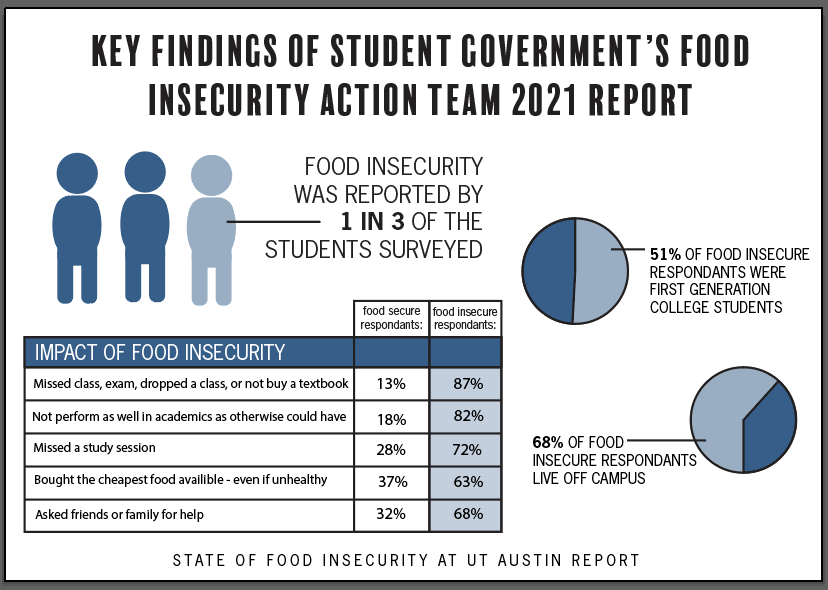‘I just want to live a normal college student life’: Student Government report finds one-third of UT-Austin students are food insecure
June 23, 2022
Editor’s note: two paragraphs were removed from this story due to an inaccuracy. The Texan regrets this error.
Going out to eat with friends is not a decision Maria said she gets to make anymore — she can’t afford it. Instead, she’s had to choose between purchasing textbooks or buying groceries.
“For someone who’s two years out of high school, it wasn’t something that I was expecting to have to stress about,” said Maria, a UT student who asked The Daily Texan not to print her full name. “It’s so difficult to have to explain to your professor why you didn’t turn in an assignment — because you were making a financial decision that could impact whether you ate for that week.”
Maria is a part of the 32% of UT students surveyed who are food insecure, according to a report released by Student Government’s Food Insecurity Action Team at the end of the spring semester. The report found that the rate of food insecurity at UT is over three times higher than the national average of 10.5%, according to the U.S. Department of Agriculture.
The team surveyed about 430 students and considered a variety of factors that lead to students being disproportionately affected by food insecurity. These factors included race, sexual orientation, first-generation status, living on or off campus and access to reliable transportation, the team’s chair Krisha Tripathy said.
“Our goal was to get information that would get to the heart of the problem,” biochemistry senior Tripathy said. “Rather than having more solutions thrown out into the universe of our University that were just blanket solutions for the problem without really understanding what the problem was.”
The report found that the highest rates of food insecurity among respondents were Black students at 60% and Latinx students at 57%. It also found that LGBTQIA+ students were nearly two times more likely to be food insecure, while first-generation students were over three times more likely.
Kathleen Harrison, assistant director of University Marketing and Communications, said UT is “committed to identifying and combating food insecurity on campus,” and suggested the UT Outpost, University dining plans and student emergency funds as resources for food-insecure students.
The report found that 90% of its respondents have never used UT Outpost, and of those respondents, 74% identified as food insecure.
Valeria Martin, Student Emergency Services coordinator for UT Outpost, said they are working to increase outreach to students. One of the ways they are doing this is by tabling on Speedway and utilizing satellite pantries located in Patton Hall, the Gender and Sexuality Center, the LBJ School of Public Affairs and the Perry-Castañeda Library.
The Food Insecurity Action Team made several recommendations for UT to help its students with food insecurity, including increasing funding to the UT Outpost and University Housing and Dining and the creation of a bus line directly from campus and Riverside to grocery stores.
In the fall, Tripathy says the team plans on expanding as an organization and starting a pilot program with SG’s Sure Walk to take students from campus to grocery stores.
Maria said the inability to afford food or have reliable transportation to the grocery store feels like a constant battle. She said it not only affects her academically but socially.
“I just want to live a normal college student life,” Maria said. “I have to be stressed about school, but I also have to be stressed about making a social life here at UT, and then … I also have to be stressed about my entire livelihood and financial stability.”











